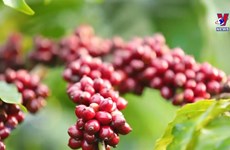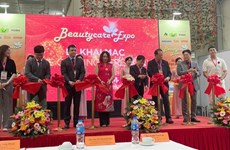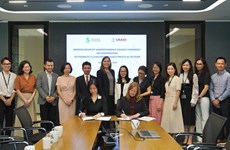Partnership deal helps drive Vietnam-Japan trade
The Vietnam-Japan Economic Partnership Agreement (VJEPA) that took
effect in October 2009 has significantly increased trade between the two
countries, a conference heard in HCM City on Nov. 23.
The Vietnam-Japan Economic Partnership Agreement (VJEPA) that took
effect in October 2009 has significantly increased trade between the two
countries, a conference heard in HCM City on Nov. 23.
Tadashi Kikuchi, economic attache at the Japanese Consulate General in the city, told the conference held to review two years of VJEPA that the trade had expanded by more than 20 percent last year to 16.7 billion USD.
It topped nearly 15 billion USD in the first nine months of this year.
With the reduction or elimination of tariffs on several Vietnamese goods under the agreement, seafood, textile and garment, and vegetable exports have been robust.
The Vietnam Association of Seafood Exporters and Producers (VASEP) said the tariff reduction has improved the competitiveness of Vietnamese products.
Truong Dinh Hoe, VASEP general secretary, said Japan is now Vietnam 's largest buyer of frozen shrimp with imports of 397 million USD in the first nine months.
Overall seafood exports were worth 668 million USD, an increase of 4 percent over the same period last year, with tuna, cuttlefish, and octopus being the main items besides frozen shrimp.
Some other sectors like garment and textile, footwear, fruit and vegetables, electrical products and cables, and wood products have also capitalised on the preferential tariffs to promote exports to Japan , Huynh Khanh Hiep, deputy director of the HCM City Department of Industry and Trade, said.
HCM City 's garment and textile exports alone to Japan were worth 445.7 million USD last year, a year-on-year increase of 6.2 percent.
They jumped 34 percent in the first three quarters of this year to 452.6 million USD, Hiep said.
Bui Huy Son, director of the Asia-Pacific Market Department, said the opportunities are huge under the trade agreement since Vietnamese textile and garments as well as 23 out of 30 key agricultural, forestry, and seafood items enjoy tariff breaks.
But Hiep said there are difficulties in exporting, including a lack of understanding of the Japanese market and business culture.
Many Vietnamese firms, especially small- and medium-sized, do not really understand the Japanese market, and that is why they struggled despite being very successful in the US and EU, he explained.
The technical barriers against farm produce and seafood in Japan and stringent quality, hygiene, and safety requirements are also major challenges for them, he said.
To crack the market, he said Vietnamese firms, particularly shrimp exporters, should improve their technologies to enhance quality.
Kikuchi said: "Vietnamese enterprises should establish long-term relationships with their Japanese counterparts and understand their business culture."
They must research the Japanese market and customers' tastes to know how to pitch their products and services effectively, he said./.
Tadashi Kikuchi, economic attache at the Japanese Consulate General in the city, told the conference held to review two years of VJEPA that the trade had expanded by more than 20 percent last year to 16.7 billion USD.
It topped nearly 15 billion USD in the first nine months of this year.
With the reduction or elimination of tariffs on several Vietnamese goods under the agreement, seafood, textile and garment, and vegetable exports have been robust.
The Vietnam Association of Seafood Exporters and Producers (VASEP) said the tariff reduction has improved the competitiveness of Vietnamese products.
Truong Dinh Hoe, VASEP general secretary, said Japan is now Vietnam 's largest buyer of frozen shrimp with imports of 397 million USD in the first nine months.
Overall seafood exports were worth 668 million USD, an increase of 4 percent over the same period last year, with tuna, cuttlefish, and octopus being the main items besides frozen shrimp.
Some other sectors like garment and textile, footwear, fruit and vegetables, electrical products and cables, and wood products have also capitalised on the preferential tariffs to promote exports to Japan , Huynh Khanh Hiep, deputy director of the HCM City Department of Industry and Trade, said.
HCM City 's garment and textile exports alone to Japan were worth 445.7 million USD last year, a year-on-year increase of 6.2 percent.
They jumped 34 percent in the first three quarters of this year to 452.6 million USD, Hiep said.
Bui Huy Son, director of the Asia-Pacific Market Department, said the opportunities are huge under the trade agreement since Vietnamese textile and garments as well as 23 out of 30 key agricultural, forestry, and seafood items enjoy tariff breaks.
But Hiep said there are difficulties in exporting, including a lack of understanding of the Japanese market and business culture.
Many Vietnamese firms, especially small- and medium-sized, do not really understand the Japanese market, and that is why they struggled despite being very successful in the US and EU, he explained.
The technical barriers against farm produce and seafood in Japan and stringent quality, hygiene, and safety requirements are also major challenges for them, he said.
To crack the market, he said Vietnamese firms, particularly shrimp exporters, should improve their technologies to enhance quality.
Kikuchi said: "Vietnamese enterprises should establish long-term relationships with their Japanese counterparts and understand their business culture."
They must research the Japanese market and customers' tastes to know how to pitch their products and services effectively, he said./.













